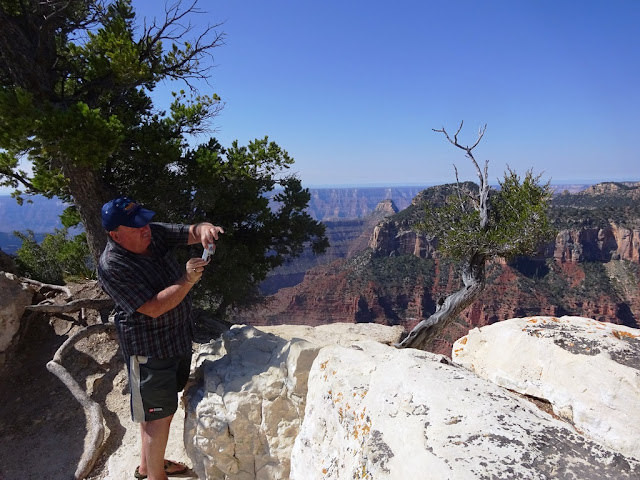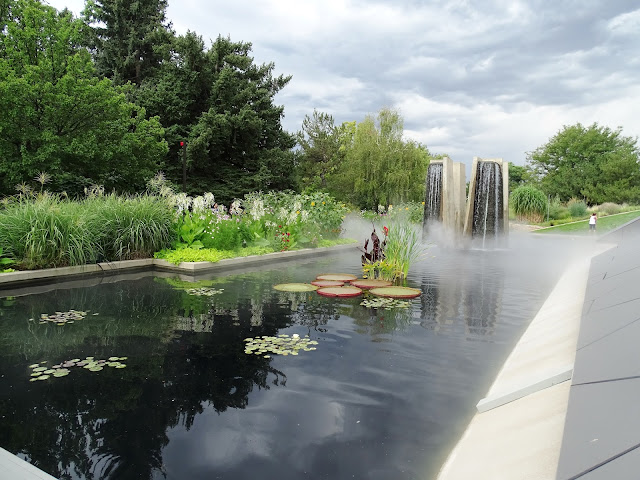 |
| Org (Georg) Fritz photographing Zauschneria californica var. latifolia |
Epilobium canum for botanical purists! This picture was taken on Monday in Sequoia National Park--a mile or so from "General Sherman"--the largest tree by bulk on planet Earth. This is the most widespread zauschneria in the Sierra: and probably the commonest of the species in the wild. It loves to grow along the road as you can see--but I've seen it in the past in screes from fairly low elevations to well above treeline in the Sierra...
 |
| Zauschneria californica var. latifolia |
I was so delighted to find this flashy colony I shall inflict quite a few closeups of the grouping for your delectation: of course, not everyone likes hot red flowers. Most fellows do, however...
Botanists, largely at the behest of Peter Raven [world authority on Onagraceae as well as the ultimate honcho of public gardening--and paleobotany while we're at it] was responsible I believe for the lumping of
Zauschneria--for no doubt excellent reasons. I presume the DNA puts it in the middle of
Epilobium (let's hope so anyway: otherwise the lumping really would be a hoax). I'm sure that there are many compelling reasons for the lumpification: and I don't really have a problem botanists shuffling things about (job security and all that!)--but it's obvious this little tribe is definitely working hard to distinguish itself from its wan, pink, mesophytic cousins. Let's fast forward a few million years--by then, these will be utterly dissimilar--much as birds are from extinct dinosaurs! Aha! I hear applause and accolades from the spheres: The botanists of the future agree...
 |
| Zauschneria californica var. latifolia |
The dis-distinguifictionalizing (to coin a word worthy of the action) of extraordinarily recognizable entities to prove a taxonomic point seems to me to belie the very fact that taxonomy was invented to recognize distinct distinctions--like xerophytic epilobioids that are hummingbird pollinated and have distinct geographical, edaphic and morphological features that distinguish them from one another. I grant you that the California zauschies are superficially extremely similar to those of the Rocky Mountains and Colorado Plateau (those are coming up): I believe a sort of violence has been done to these by scrunching them all under the single rubric of "Epilobium canum"...
 |
| Zauschneria californica var. latifolia |
 |
| Zauschneria californica var. latifolia |
Here is a wonderfully silvery form of
californica--the most variable of the taxa in my experience.
 |
| Zauschneria californica Selection in Mike Kintgen's Denver Garden |
 |
| Zauschneria californica 'Etteri' at Kendrick Lake |
And yet another very distinctive clone: this one has grey-bluish leaves...a fabulous garden plant.
 |
| Zauschneria arizonica taken today at Zion National Park |
You can imagine my delight when we found oodles of
Zauschneria arizonica along the highway in Zion Park today. The lumpers have grouped this with the last species--as they have the next one coming up. Despite the much greener foliage, the larger habit, more orange flowers (I know all these characters blur--and it does resemble some forms of
californica to be sure). But this is consistently tetraploid, and has a very distinct geographical range far to the east..distinctions that are not honored by the lumped epithet.
 |
| Zauschneria arizonica taken today at Zion National Park |
Can't resist sharing a few more shots of this...
 |
| Zauschneria arizonica taken today at Zion National Park |
 |
| Zauschneria arizonica taken around 1990 at my old house (Daughter Eleni in the middle) |
In the garden I have found
Z. arizonica to be the largest, and most robust of the species. Here in my unwatered xeriscape it often grew over a yard tall, and with water grew much larger. It's a monster! But not nearly as cute as my daughter...
 |
| Zauschneria arizonica taken today at Sandy Snyder's garden in Littleton |
Here's a massive specimen in Sandy Snyder's fabulous garden--which will host our chapter's plant sale in a week and a half--it should be blazing then!
 |
| Zauschneria garrettii in the wild |
Again obscured by the nomenclatural muddling--this distinctive species grows far to the north and east of all the others--I've seen it many places in northern Utah, Wyoming and Idaho--often near tree line. Here is the first colony we found thanks to a Casper horticulturist who directed us here--above a reservoir on the Wyoming-Idaho line, not far from Afton.
 |
| Zauschneria garrettii at Kendrick Lake |
Z. garrettii is diploid, grows far to the north of
Z. arizonica, but resembles it in many ways, although it is much more compact. It also begins blooming two months earlier: I've seen flowers on this in May some years. Obviously not as daylength sensitive as the lowland species. As a consequence, it's the best plant to grow at altitude (and also to enjoy earlier in the summer)...
 |
| Zauschneria garrettii at Yampa River Botanic Park |
Here is a stunning spread of it at a ski town in Northwest Colorado--where the growing season is very short.
 |
| Oenothera speciosa (dwarf pink form--outside Sequoia National Park) |
Just to confuse you, I toss in this distant cousin I photographed the other day outside Sequoia in a private garden: it's a native of the Southern Plains, but I've never seen such a stunningly dwarf and dark pink form. I had a long time to travel in the car--otherwise I'd have begged a piece.
 |
| Oenothera speciosa (dwarf pink form--outside Sequoia National Park) |
|
Here's another
Oenothera speciosa I stumbled upon in south Denver a few years ago--not as deep a pink as the California one, but very desirable. I need to beg a piece of this--I stumble on far too many good things!
 |
| South Denver Oenothera speciosa |
 |
| Closeup of South denver Oenothera speciosa |
Isn't this
Oenothera speciosa simply scrumptious? Of course, it spreads like wildfire! Which (you notice how deftly I returned to the initial theme?)
 |
| Epilobium fleischeri (in the Rock Alpine Garden, Denver Botanic Gardens) |
|
I have to give the botanists their due: this is vaguely reminiscent of a
Zauschneria--and it's not exactly mesic (I saw it growing on quite dry habitats in the Eastern Mediterranean this summer). I'm sure the phylogeny and morphology and probably the genetics put the zauschnerias comfortably in
Epilobium: but just as
Dodecatheon begs to be recognized for its distinctive shape and geographic separateness from
Primula (and let's not even talk about
Dionysia)...these subsets of huge genera--like
Oxytropis within Astragalus--beg to have some recognition...and the distinctive distribution of specific taxa should definitely not be erased in Floras when they scream out on the roadside or the garden.
 |
| Epilobium (photographed in June, 2010 in Kansas) |
|
Now THIS is what I think of when I hear
Epilobium: there so many tiny, pale, wan things in the genus. Let's not insult them by sticking them in the same corral as those fiery plants which have all the subtlety of drag queens or forest fires!
















































































































